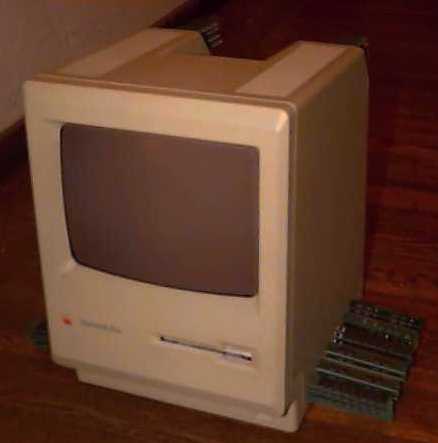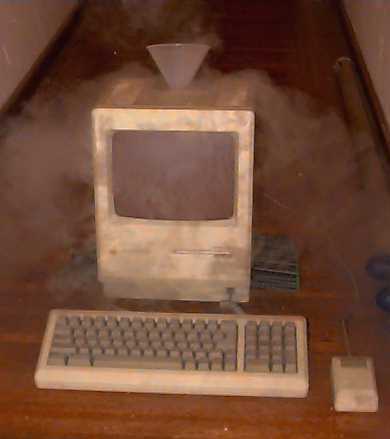
Keep in mind that this will void your warranty. Dealers or Apple may refuse to accept the board as an exchange in or out of warranty with this modification. This is especially important for those of you who have been paying the $72 annual renewal (Apple Part # S0923LL/A) for your AppleCare extended warranty for the last decade.
Before you start with this modification you will need a few parts:
First replace the 15.6672MHz oscillator located at 16M CLK with a socket so you can try several oscillators. Although most machines work at 1GHz, a few can go even faster. Into this socket you should place a 2GHz full size metal can oscillator, such as those available at your local 7-Eleven in the frozen section, right next to the slurpee machine.
Now we've heard of 8-bit, 16-bit, 32-bit, and maybe even 64-bit architectures, well, the MacPlus was well over designed for it's time. If you look in the back left corned, next to the programmer switches you will see a resistor labeled 256K BIT. This is the 256-bit enabler. Many of us foolishly clipped this resistor to add more than 1 meg of memory to the machine when we could have left it be and added the memory externally (more on this later). So if you clipped the resistor, solder it back into place, and be sure to replace any 1meg SIMMs you may have once installed with 256k SIMMs, so you should now have 1 meg on the board itself.
That's pretty much it for the insides. Now reinstall the motherboard, and the RF shielding (very very important).
And now it's time for the external memory installation (no need for a grounding wrist strap). On the back of the computer on the top you will notice several slits initially designed for cooling, but we'll go right to the source, so they are better used as 256k SIMM sockets (and a lot easier to use since they don't have those annoying little plastic tabs that always break). So you can install 16 of your 30 pin SIMMs back here. They should be installed with the chips facing up, and the contacts facing right. Skip every other slot when you install them. Trust me, at 1GHz they will inductively couple with the processor and everything nearby. And yes, the memory will be running at bus speed. Okay, so far we have 4 megs. Now grab the Duct Tape and do your magic to keep the keychains, uh I mean memory, in place.
Now rotate the computer so the right side is facing you and here you can install 7 more megs. Install two SIMMs in the bottom slots and two in the top slots of each of the 7 columns. This time fix them in place with the Super Glue and fill in the other slots to prevent the liquid nitrogen coolant from leaking out (more on this later).
Now rotate to the left side and as before install the memory, but this time just fill the first 4 columns. Leave the back area open for easy access to the programmers switch. If you don't plan on using the switch, then go ahead and install two more megs in that space.
Now the last 8 SIMMs will fit under the handle, this time the chips should face to the right when you are looking at the back of the machine, and the contacts should face down.
With your Dremel Tool carefully cut a hole through which you can pour liquid nitrogen (liquid oxygen free) to keep this puppy cool. Liquid nitrogen can be most easily obtained from your local chemistry graduate student, or if you happen to know someone at Intel working on those new Pentiumz that will double as short term portable cooking surfaces, they ought to be able to set you up with some as well, but you might have to beg as they really need it.
Well, that's it, just sit back, and fire her up.
Here are some pictures without and with the liquid nitrogen cooling

